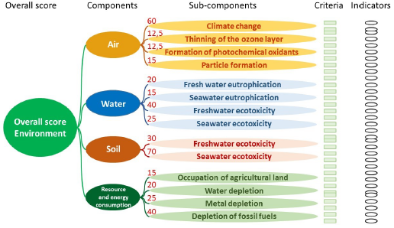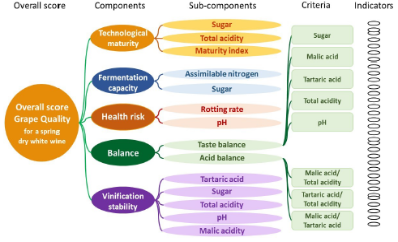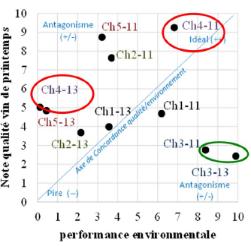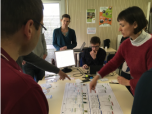Contents
- How to evaluate the double perfomance on a plot?
- From evaluation to eco-quali-design
- How to design dual perfomance technical management routes?
- How to achieve economic performance through eco-quali-design?
- Eco-quali-design, a promising tool for the ecological transition!
Eco-Quali-Design:
in designing and developing a product
- by integrating environmental aspects and quality
- with the objective of reducing negative environmental impacts throughout the product's life cycle.
The concept was developed in Angers by the GRAPPE Group of Research in Agri-Food Products and Processes (ESA-INRA) for the Eco-quali-conception© of agricultural and food production systems. Researchers are developing well-equipped approaches adapted to the needs of high value added production chains committed to quality labels, such as the Wine sector. These procedures are established at different scales, from the plot to the fram and then to the territory.
How to evaluate the double perfomance on a plot?
Development of a tool to evaluate the dual environmental and quality performance of agricultural technical management routes, within the framwork of the QUALENVIC project - QUALENVIC - QUALITY, ENVironnement, Consumers (2012-2016, CASDAR funds)

Qualenvic
- Coordinated by USC GRAPPE (ESA-INRA) and conducted with 20 research and development partners
- An original objective: to provide producers and consultants with methodological and technical keys to accompany the change of practices towards a duals environmental and quality performance
- A particulary welcome approach for agricultural products with quality labels (AOC)
- An analysis of consumers' perceptions of environmental labeling on their products.

QUALENVIC project

QUALENVIC projectSandra Beauchet completes her thesis (
GRAPPE
, 2013-2016, funded ADEME and Région Pays de la Loire), as part o the
QUALENVIC project
.
She has developed a multi-criteria method for evaluating vineyard technical management routes whiche combines both:
- Environmental assessment: by LCA applied to vineyard technical management routes
Tree for environmental assessment of crop management techniques

Environmental assessment
Evaluations are carried out on the basis of indicators: raw data from field surveys or measurements on grapes. They are aggregated into criteria and them into sub-components, which when combined give the overall rating in the form of a score of 0 to 10.
- Quality assessment : of grape berries, by physico-chemical analysis
Tree for evaluating the quality of the Chenin grape variety for the production of spring dry white wine.

Quality assessment
It is the CONTRA-QUALENVIC calculation tool (under excel), developed from the CONTRA method (Inra COLMAR), which allows aggragation, according to decision rules and weightungs defined with experts.

Performence environmentale
By crossing the Quality and Environment scores,it is possible:
- to visualise how the technical management routes studied are in relation to each other
- to follow the progress of an management route after changes in practices
- to observe interannual variations
The plot followed belong to the ACO Muscadet Anjou / Saumur / Touraine
The method has made it possible to identify promising technical management routes for improving environmental perfomrance while guaranteeing the quality of the grapes. The Ch4 plot in 2011 bears witness to this
Eco-efficiency matrix of the 5 technical management routes observed for Chenin blanc for spring dry white wine in 2011 (noted "11") and 2013 (noted "13").

Frédérique Jourjon
Frédérique Jourjon
f.jourjon@groupe-esa.com
Pereption of environmental labeling on products
Professionals in the wine industry: strong reservations about environmental labeling, BUT a marked interest for:

environmental labeling
- environmental certification procedures for companies
- LCA as a tool to help decision makers decide on practices to move towards an eco-design approach
Consumers: made aware of eco-labels BUT:
-
lost because of the diversity of ecolabelsas they only know outside the Organic Agriculture logo
environmental sensitivity dependant on their involvement with the product and the environment
considering the AOC and terroir the as a guarantee of environmental respect
Ronan Symoneaux
Ronan Symoneaux
r.symoneaux@groupe-esa.com
From evaluation to eco-quali-design
How to design dual performance technical management routes?
Development of a collective eco-quali-design approach.
Anthony Rouault's thesis ( GRAPPE 2015 -2018, funded by ADEME and the Région Pays de la Loire) aims to create and test a collective eco-quali-design approach of vineyard technical management routes, i. e. at the plot scale.
This approach integrates the two quality and environmental performance objectives, based in particular on the evaluation tool developed in the
QUALENVIC project.
The approach follows a co-design process with winegrowers and their advisors.

Christel Renaud
Christel Renaud

eco-quali-design approach
Objectives:
- Raising awareness and involving winegrowers in eco-design initiaves.
- Thinking with winegrowers about environmental impacts.
- Collectively eco-designing technical management routes that are more environmentally friendly and preserve the quality potential of the grapes.
The approach is simplemented with two groups of winegrowers during sessions of three workshops.
A. Rouault is developing original tools that will make it possible
- ownership of LCA results by participants
- real-time evaluation of collectively designed tehnical management routes.
How to achieve economic performance through eco-quali-design?
Development of an on farm eco-quali-design approach, including co-design with stakeholders and a socio-economic dimension, through two projects:
ECO3VIC project - ECOCOnception COllective in Vitiulture to support the charge of practices (2017-2020, funded by ADEME)
SCALE project (2018-2019, funded by University Bretagn-Loire): Magdalena Czyrnek Delêtre will develop the LCA on an operational scale.

Frédérique Jourjon
Frédérique Jourjon
f.jourjon@groupe-esa.com
ECO3VIC project led by the USC GRAPPE (ESA-INRA) and the LARESS (ESA) is in close contract with the stakeholders in the wine industry: consultants, wine growers, cooperatives.
- Creation of a database of practices including production costs and environmental perfommance,
- Integration of the economic dimension into the collective eco-design of technical management routes
- Farm-scale approach
- Analysis of the socio-economic barriers ans level to change practices
- Objective of tranfsferring the process to regional advisors and technicians
|
|
This project includes A. Rouault's thesis work on collective eco-design.
Eco-quali-design, a promising tool for the ecological transition!
Perspective of developong an approach to build systems at the scale of territory, marking it possible to combine: impact mitigation, climate change adaptation and quality preservation.

From 2018, the AVATED project (ERDF fund) will set up an approach to support producers in changing practices at the leel of the territory (AOC) based on the development of envinmental assessment by LCA at the level of the territory.
The process will be carried out in collaboration with ecologists. It will contribute fully to the agro-ecological transition process by taking into account the multi-functionality ofthe territory, for example by setting up hedgerows in favour of biodiversity.
Innovation at the territorial level and for the group.
Contacts
Looking for partners?
Two contacts to support your projects:
- Anna Pineau,
![]() contact to support your R&D projects and put you in touch
contact to support your R&D projects and put you in touch
anna.pineau@
- Tanegmart Redjala
![]() Close interface with the laboratoires of the Federative Research Structure "Quasav"
Close interface with the laboratoires of the Federative Research Structure "Quasav"
tanegmart.redjala@univ-angers.fr
- Christel Reneaud-Gentié
![]() head of eco-quali-design topic USC GRAPPE (ESA-INRA),
head of eco-quali-design topic USC GRAPPE (ESA-INRA),



